In today’s world, AI has revolutionized our interactions, not only communicating with us but also creating images on demand. The AI image generation market is set to reach billions by 2025. However, with the plethora of options available, identifying the best AI image generators poses a challenge.
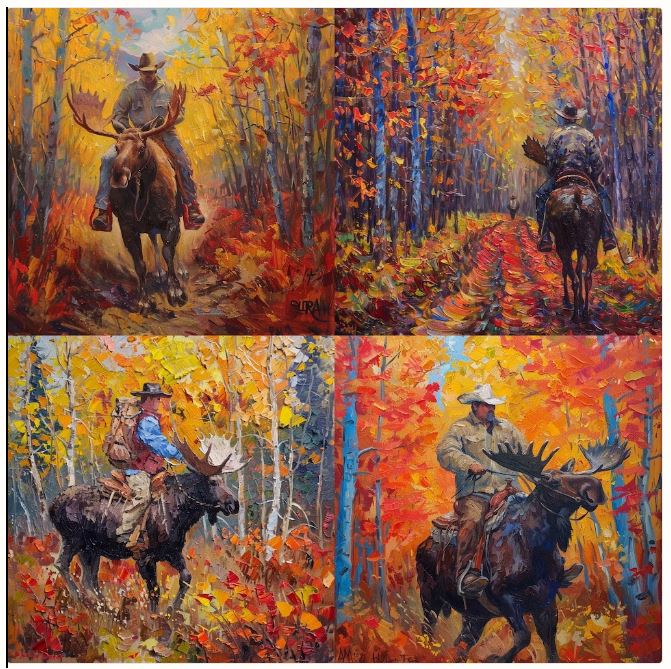
Professional photography is very costly, and sometimes doesn’t even produce desired results. That’s where AI image generators come into play. You can produce unlimited pictures based on your text prompts. If you don’t like them, alter the prompts to produce the desired result. To make your work easier, we have compiled a list of the 8 best AI image generators of 2024.
What Are AI Image Generators, and How Do They Work?
AI image generators are tools that produce realistic images based on your text prompts. AI image generators work by interpreting your text descriptions and trying to create visuals that fit. The interpretation works based on their training or information stored in them. They are algorithmically programmed to understand your texts and produce the desired results.
The AI generators work on a program called Generative Adversarial Networks (GANs). The GAN is a combination of two networks. One network, the generator, creates realistic images based on the textual prompts it receives. The generator starts by creating a rough draft, like a child’s first attempt at a drawing.
This draft is then evaluated by the other network, the discriminator. The discriminator compares the generated image to real photographs and highlights any discrepancies. Based on the discriminator’s feedback, the generator refines its creation, adding details, adjusting colors, and improving the overall realism.
This iterative process continues in a loop, with the generator constantly learning from the discriminator’s feedback until it produces an image that fools the discriminator into believing it’s a real photograph. It’s like a student trying to get approval for his homework from his teacher. This process may seem cumbersome, but it takes place in seconds.
Top 8 AI Image Generators In 2024
Now that we know a little bit about AI image generators, let’s see which are the best AI image generators of 2024. There are various factors to consider when deciding the best generator. It includes the ability to understand text prompts, the time it takes to produce an image, how much the image matches, realism, etc. Based on these, here are the top AI image generators in 2024.
1. Midjourney
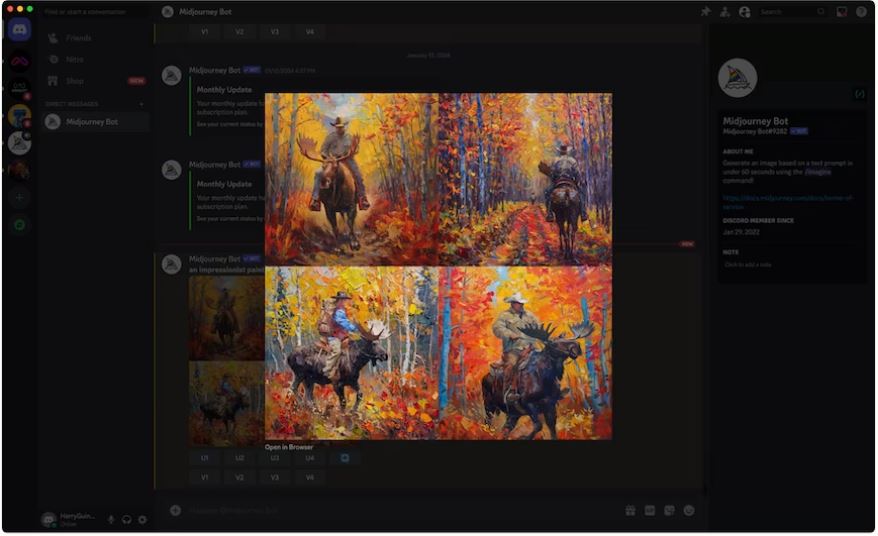
Midjourney is the best AI image generator on the market right now. It consistently produces stunning results, with realistic textures, colors, and overall better visual appeal. It excels at realistic depictions of people and objects. The tool understands your texts in the best way and produces images that match your description.
Currently, the beta version is available only on Discord. You have to use Discord to write text prompts. The tool will provide 4 variants based on your prompts. However, the company is working to bring the tool to the browser. The free trials have been discontinued owing to the exploitation of the tool by many users using different IDs to use the free trials. The Basic Plan starts at $10/month for around 200 images and allows commercial use.
PROS:
- Top-Quality Images: Provides the most visually appealing and polished AI-generated images.
- Inspiring Community: Offers a diverse community for sharing ideas and gaining inspiration.
CONS:
- Discord Dependency: Strangely, Midjourney relies on Discord for access, limiting usability.
- Public by Default: Images you create are automatically public, potentially compromising privacy.
- No Free Trial: Free trials are temporarily unavailable due to high demand.
2. DALL.E 3
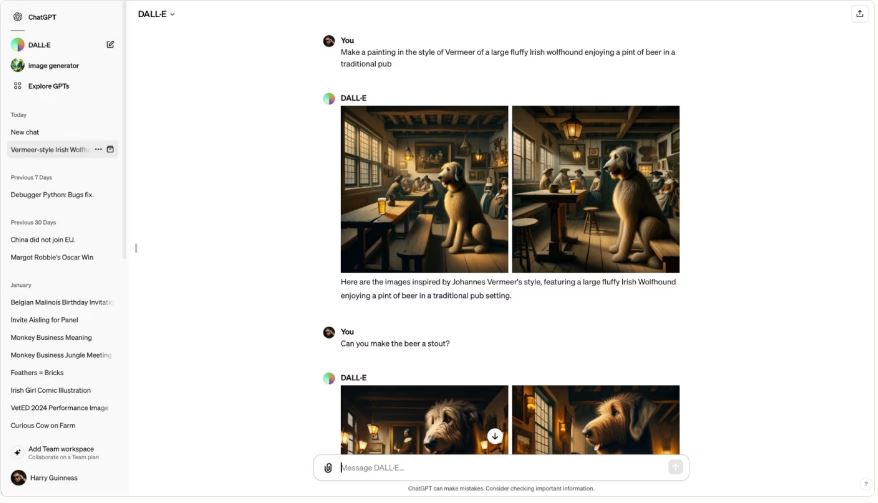
DALL-E 3 is the successor of the famous DALL-E 2. OpenAI, the company behind ChatGPT & Sora AI, introduced DALL-E 2 as its image-generating AI in November 2022, gaining significant popularity. Now, however, they’ve replaced it with the even more advanced DALL-E 3.
DALL-E 3 is a more powerful tool than its predecessor, but it comes at a cost. You’ll need to be a subscriber to ChatGPT Plus, a service costing $20 per month. DALL-E 3 can then be used directly through ChatGPT or its dedicated application.
Using DALL-E 3 is straightforward. Simply provide a detailed description of the image you desire, and DALL-E 3 will create four remarkably realistic images closely matching your specifications.
PROS:
- It has a user-friendly interface, and even beginners can get great results.
- It comes bundled with ChatGPT Plus, so you get two services on one payment.
CONS:
- ChatGPT’s interface can sometimes be unreliable for image generation.
- $20/month may feel expensive if you’re primarily interested in only image features.
3. Stable Diffusion (Dream Studio)
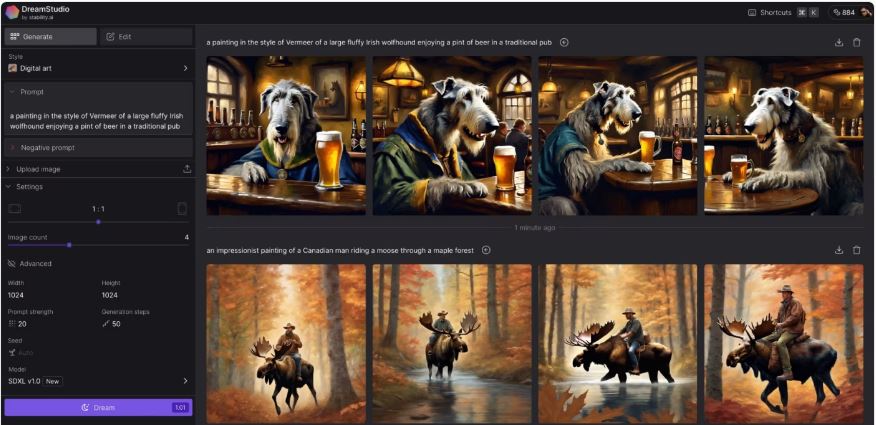
Stable Diffusion is an open-source platform, unlike DALL-E and Midjourney. This lets anyone with some technical expertise download and run it directly on their computer. It also allows for training and fine-tuning the model for specific tasks. Many services that use AI to generate creative portraits, historical figures, architectural designs, and more rely on stable diffusion in this way.
If you have the technical skills and want to create something amazing with AI, stable diffusion is currently the best option. There’s even an API available, along with a service called Clipdrop that offers a user-friendly set of tools built on Stable Diffusion.
PROS:
- Uniquely offers free credits, making it a budget-friendly way to explore AI art.
- Provides exceptional affordability and flexibility, delivering powerful customization and impressive results.
CONS:
- Requires more effort to master than other competing AI art tools.
- DreamStudio’s (Company behind Stable Diffusion) built-in editing tools could be more user-friendly.
4. ImageFX by Google
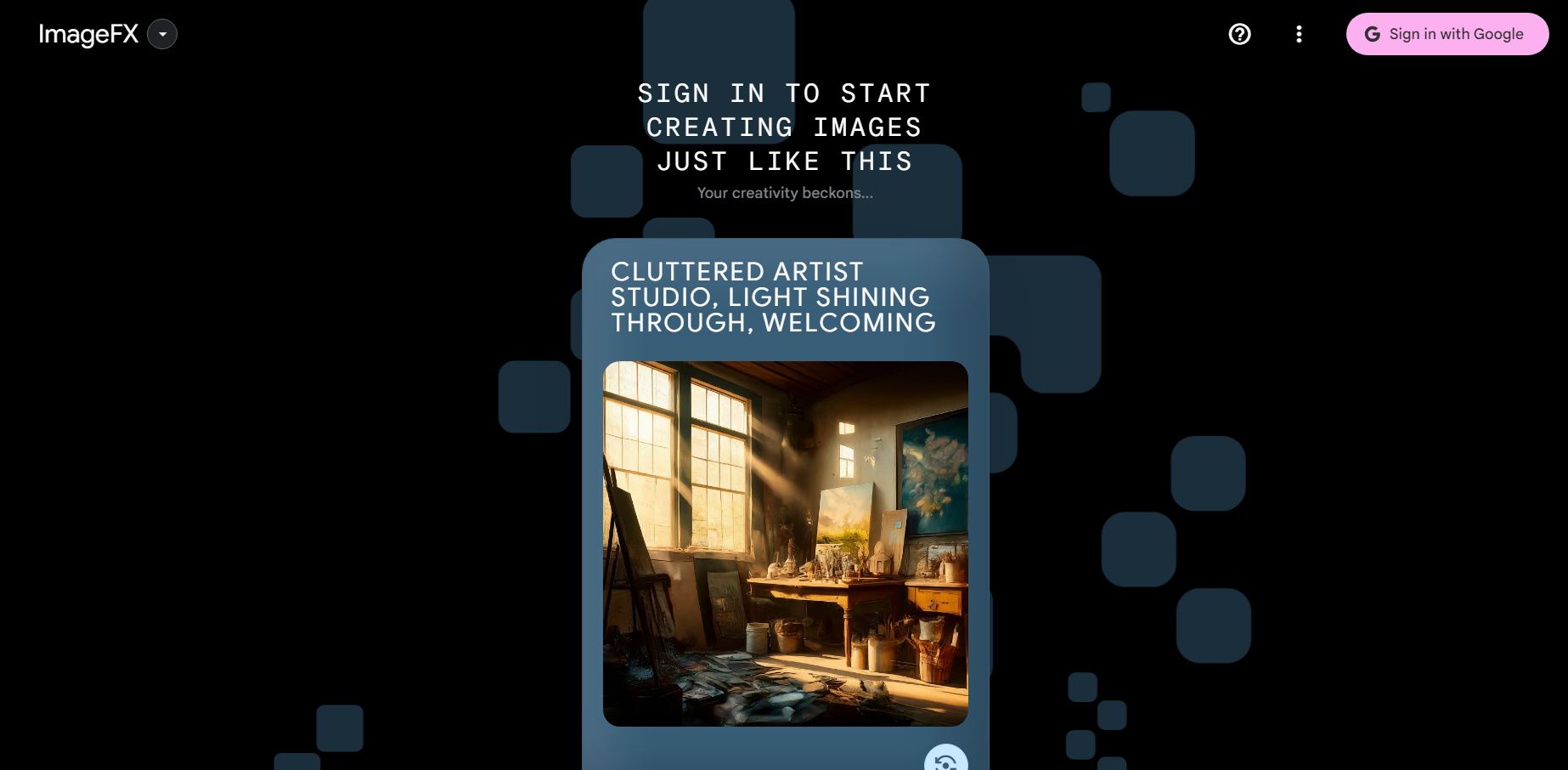
Google’s ImageFX arrived later than competitors like DALL-E 2, but it was worth the wait. The generator delivers high-quality, realistic images and even produces elements that are difficult to render such as hands. Most of the generators face difficulty rending hands of characters, but no ImageFX.
ImageFX stands out with its “expressive chips” feature. The feature allows users to alter any part of the image produced. For example, if you produced an image in which you don’t like a particular portion, you can use the feature to alter that particular portion.
Plus, ImageFX offers style suggestions (photorealistic, sketch, etc.) making it an excellent choice for beginners who want to explore the possibilities of AI art generation. All these at free of cost.
PROS
- User-friendly interface makes it easy to get started.
- Produces stunning, high-quality images.
- “Expressive chips” offer creative suggestions for refining your ideas.
CONS
- Requires a Google account to use.
- Strict content guidelines may sometimes feel restrictive.
5. NightCafe
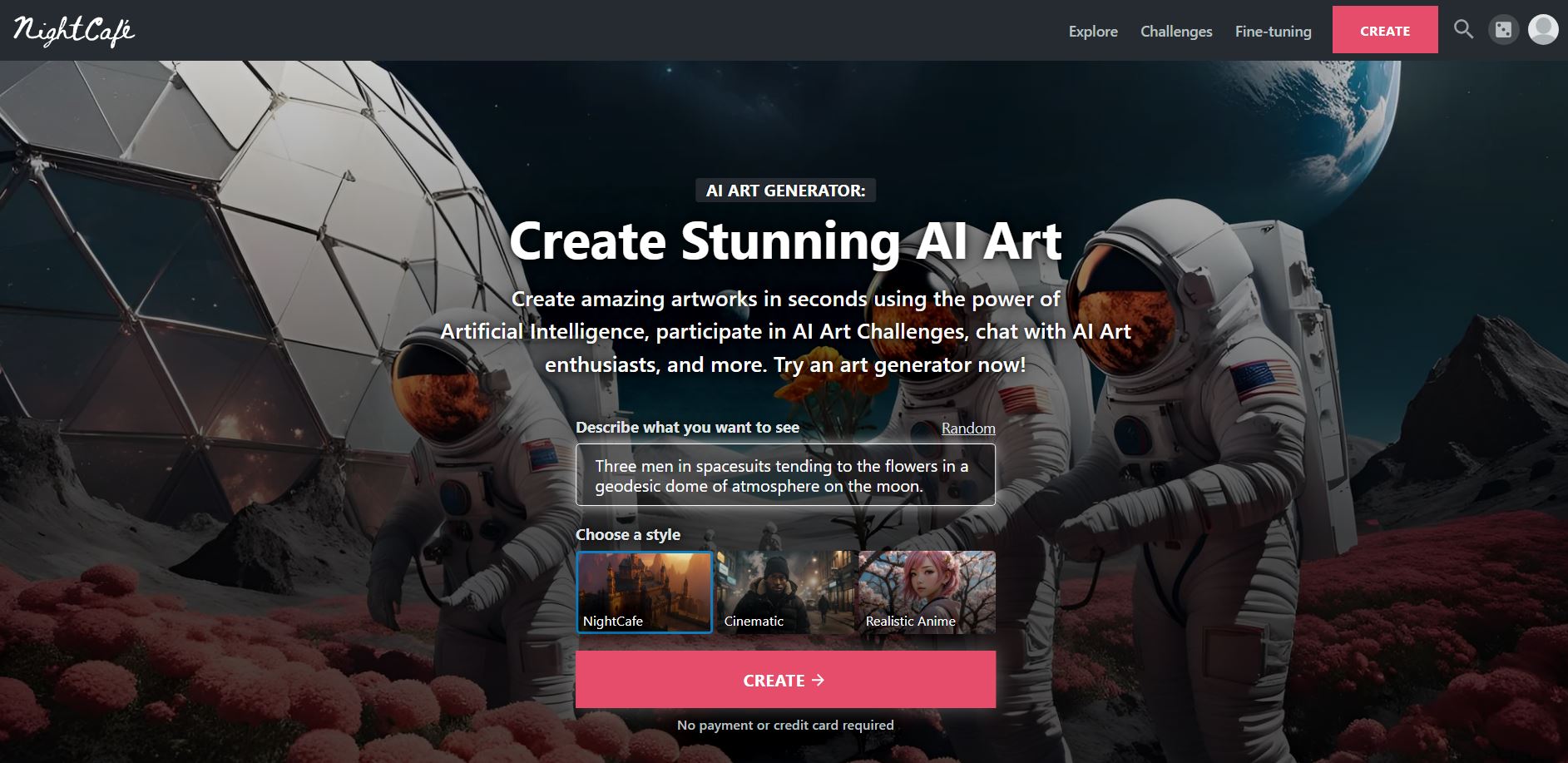
Nightcafe is another AI image generator created by the tech giant NVIDIA. It stands out as one of the few major AI image generators still offering a free option in 2024. Accessible both online and through mobile apps (Android and iOS), it’s a user-friendly choice.
Keep in mind that the free version limits you to five credits per day to prevent overuse. If you need more, you can purchase additional credits starting at as low as $0.08 each. To get the most out of Nightcafé, understand how to use modifiers to refine your image prompts effectively.
PROS:
- Free Option: Offers a free tier, making it accessible for casual users or those wanting to try it out.
- Cross-Platform: Available on the web, Android, and iOS, providing flexibility in how you use it.
CONS:
- Daily Credit Limit: The free version restricts you to five credits per day, potentially limiting extensive use.
- Modifier Knowledge: It requires some understanding of modifiers to get the most precise and desired results.
6. Adobe Firefly
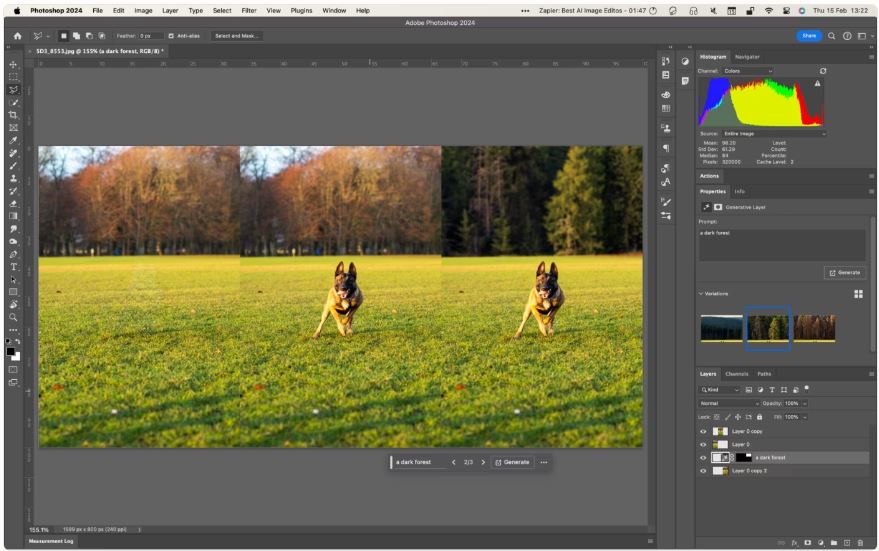
Adobe’s long history with AI tools makes its text-to-image generator a powerful contender, particularly due to its seamless integration with other Adobe products. You can experiment with Firefly for free on the web or through Adobe Express, but its true strengths are enhanced with the latest Photoshop version.
Firefly offers unique features beyond standard image generation. It can generate text effects, recolor vector art, and add AI-generated elements directly to your existing images. While this web-based functionality is impressive, it’s the integration with Photoshop that sets Firefly apart. The “Generative Fill” feature allows you to select an image area, and then replace it with something completely different using a simple text prompt. It maintains your image’s context, matching details like depth-of-field.
Firefly operates on a credit system. You can access it through various Creative Cloud plans. The photography plan (with 500 generative credits) starts at $19.99/month.
PROS:
- Photoshop Integration: Seamlessly works within Photoshop, offering a unique advantage for professionals who already use the software.
- Advanced Features: Offers capabilities beyond basic image generation, like text effects, recoloring, and its powerful “Generative Fill” for context-aware image editing.
CONS:
- Inconsistent Results: If you use only the image generator, the output can be unpredictable, sometimes excellent, sometimes less so. It is recommended to use the tool with Adobe Photoshop.
- Tied to Subscription: Requires an Adobe Creative Cloud subscription, potentially limiting accessibility for those not already using Adobe products.
7. iStock by Getty Image
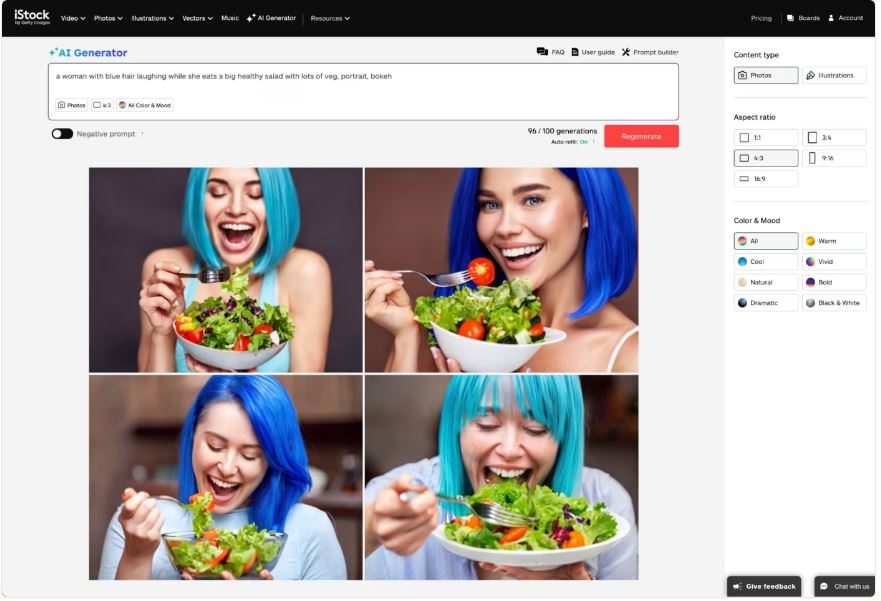
Targeted toward businesses and creatives with commercial needs, Generative AI by Getty Images offers a brilliant selection of AI-generated images that are royalty-free and commercially licensable. This platform ensures that users can leverage the power of AI image generation without copyright concerns.
Generative AI, available through iStock, is impressive, especially for stock realistic-style creations. I myself tested it, and it indeed produces very good results.
But it has some downsides as well. Generative AI won’t make anything with real people, trademarks, or anything else that could break copyright laws. This makes Getty’s tool less versatile and playful, but much more practical for businesses with legal concerns.
PROS:
- Stock Photo: It has expertise in creating classic stock photos.
- Legal Shield: This platform produces copyright-free images, so no one can claim that you have copyrighted their content.
CONS:
- Less artistic freedom: It can’t handle super creative prompts or specific art styles like competitors.
- Not the most creative: It is a more practical and less creative tool.
8. Microsoft Designer (formerly Bing Image Creator)
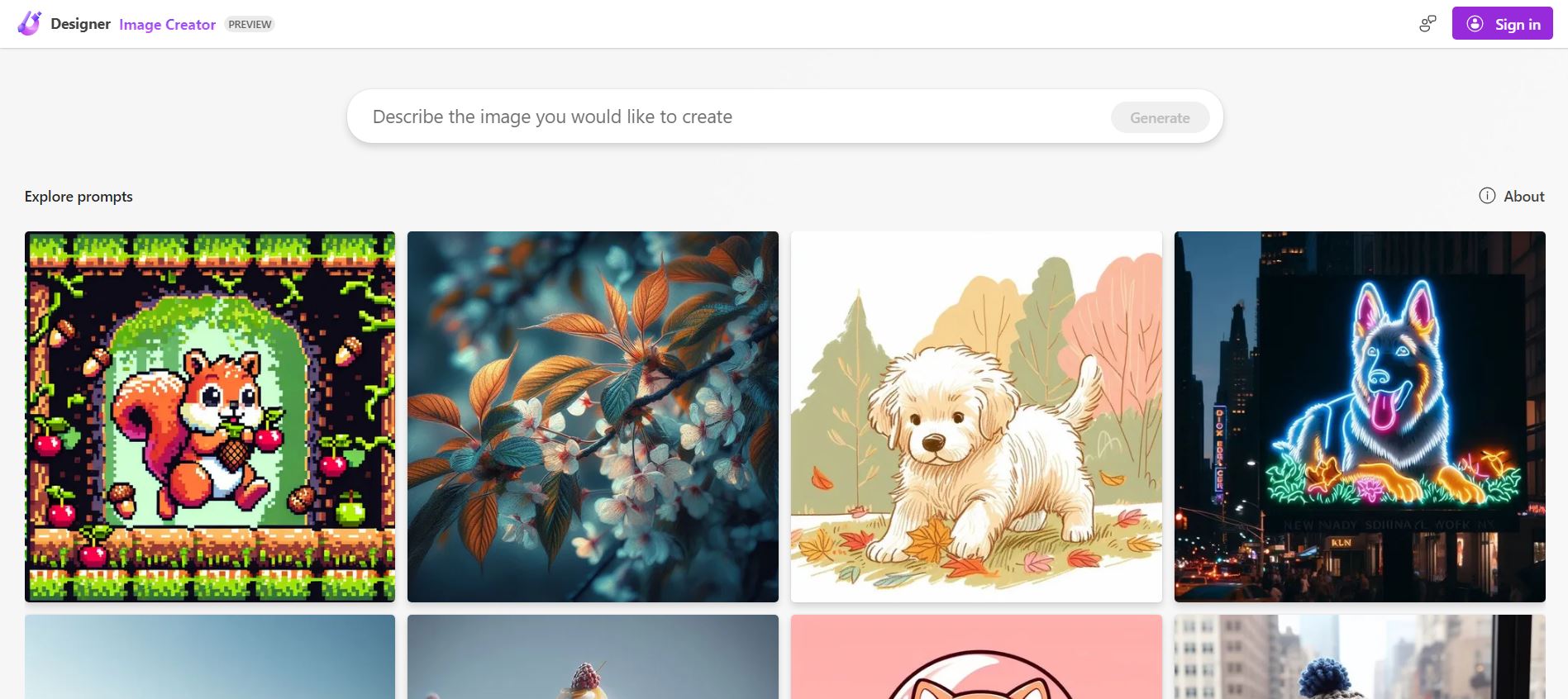
Looking for a free and easy AI art tool? Try Microsoft’s Image Creator from Bing. It’s free to use and works on any browser, not just Microsoft Edge. Though not as good as top AI image generators in terms of image quality, understanding texts, and rendering, but is still better than other AI image generators. Plus, the platform is completely free to use.
There are some limitations, like with most AI art generators. You can’t create anything violent, hateful, or NSFW. Free use also has limits. To produce more images, you need to buy a subscription. Overall, Bing’s Image Creator is a user-friendly and accessible option for creating art with AI.
PROS:
- The platform is easy to use, and even beginners can use it.
- Free of cost
CONS:
- Can’t produce NSFW content.
- Limited image productions
Conclusion
That’s our list of best AI image generators of 2024. The list is concise, yet efficient. I only added 8 generators, because they are the best in their field. Yes, there are other AI image generators as well, but they are far away in terms of output. In 2024, these generators are the best that you can get. Do try them out and let us know your favorite generator in the comment section below.
- Tricks to Unblur Course Hero Answers for Free - June 3, 2024
- Spotify Vs Deezer Vs Tidal: Which Is Better? - May 31, 2024
- Top 9 VR Action Games in 2024 - May 31, 2024